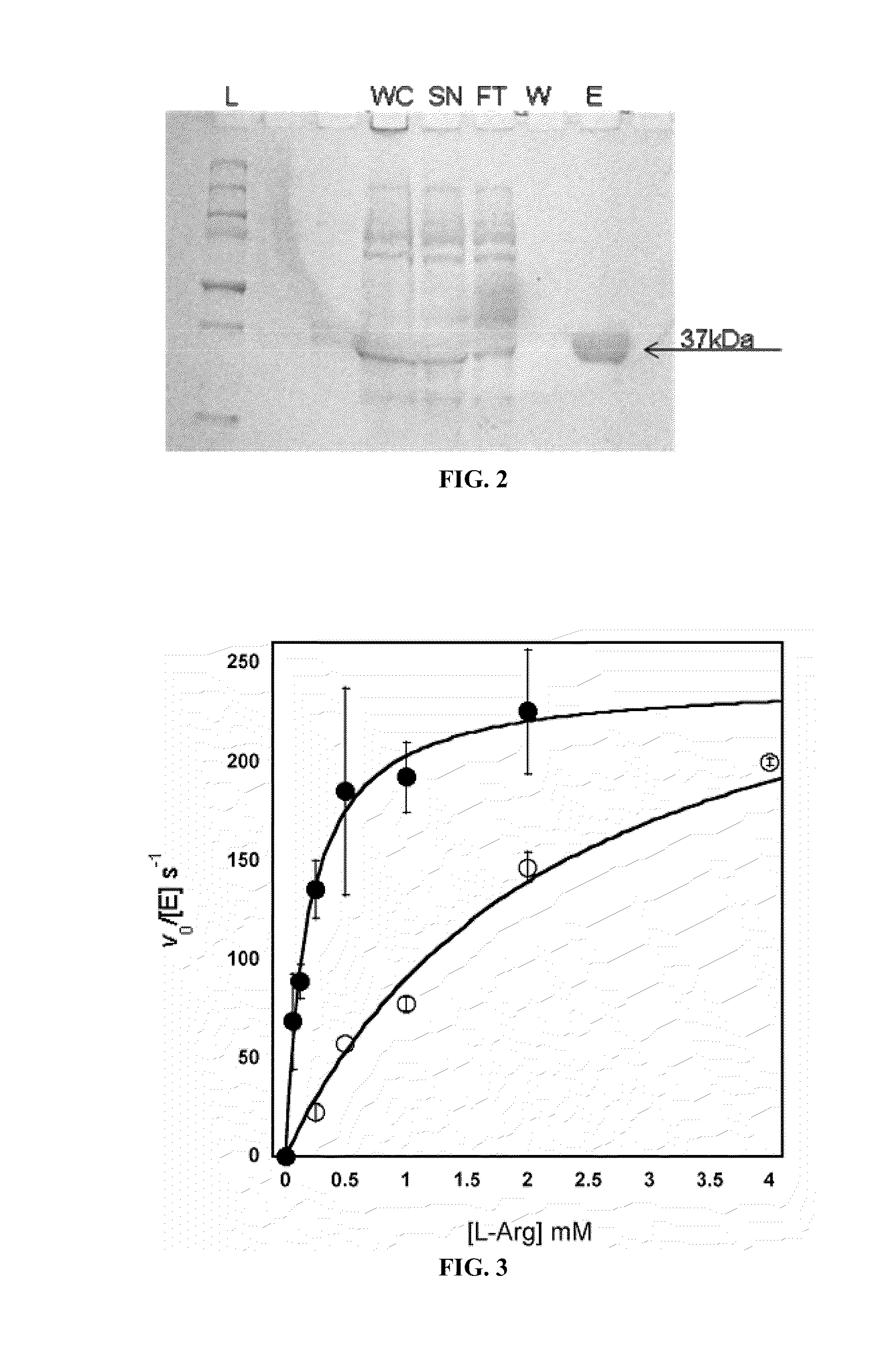Compositions of engineered human arginases and methods for treating cancer
a technology of arginases and enzymatic l-arginine, which is applied in the direction of drug compositions, enzyme stabilisation, peptide/protein ingredients, etc., can solve the problems of enzymatic l-arginine depletion, major imbalance, and rapid cell death
- Summary
- Abstract
- Description
- Claims
- Application Information
AI Technical Summary
Benefits of technology
Problems solved by technology
Method used
Image
Examples
example 1
Gene Synthesis and Expression of Human Arginase I & II
[0126]The human Arginase I and II genes both contain mutiple codons that are rarely utilized in E. coli that can interfere with expression. Thus, in order to optimize protein expression in E. coli, the respective genes were assembled with codon optimized oligonucleotides designed with DNA-Works software (Hoover et al., 2002). Each construct contains an N-terminal NcoI restriction site, an in-frame N-terminal His6 tag followed by a Tobacco Etch Virus (TEV) protease site and a C-terminal BamHI site for simplifying cloning. Cleavage by TEV protease removes the His6 peptide and the N-terminal Met of arginase. An Arginase II gene was designed with a TEV protease cleavage site and without the first native 21 aa. The first 21 aa are a putative mitochondrial-targeting sequence and its removal results in greater protein yield and stability (Colleluori et al., 2001). After cloning into a pET28a vector (Novagen), E. coli (BL21) containing a...
example 2
Incorporating and Determining Metal Content in Arginase I
[0127]As mentioned in Example 1, incorporation of Mn2+ and Co2+ can be achieved by purifying Arginase, followed by an incubation step with 10 mM metal at 50° C. for 10 min. In order to determine the final metal content and identity of the Arginase preps, protein samples of Mn-hArgI (145 μM), Co-hArgI (182 μM) and associated dialysis buffers (100 mM Hepes, pH 7.4) were diluted in 2% nitric acid and analyzed by inductively coupled plasma mass spectrometry (ICP-MS, Department of Geological Sciences, University of Texas at Austin) to quantify the protein's cobalt, iron, manganese and zinc content by subtracting the concentration of metals found in dialysis buffer from the metal concentration of the final protein samples and dividing by protein concentration. To determine protein concentrations, an extinction coefficient was calculated for hArgI based on amino acid sequence (Gill and von Hippel, 1989). All protein concentrations fo...
example 3
Incorporating and Determining Metal Content in Arginase II
[0128]Efficient metal incorporation into Arginase II was achieved by culturing E. coli harboring the ArgII gene in minimal media until an OD600 of 1 is reached, whereupon the protein was expressed with 1 mM IPTG and 100 μM CoCl2 for an additional 12 hrs. In order to determine the final metal content and identity of the Arginase preps, protein samples of Co-hArgI (290 μM) and associated dialysis buffers (100 mM Hepes, pH 7.4) were diluted in 1% nitric acid and analyzed by inductively coupled plasma mass spectrometry (ICP-MS, Department of Geological Sciences, University of Texas at Austin) to quantify the protein's cobalt, iron, manganese and zinc content by subtracting the concentration of metals found in dialysis buffer from the metal concentration of the final protein samples and dividing by protein concentration. To determine protein concentrations, an extinction coefficient was calculated for hArgI based on amino acid seq...
PUM
| Property | Measurement | Unit |
|---|---|---|
| pH | aaaaa | aaaaa |
| pKa | aaaaa | aaaaa |
| pKa | aaaaa | aaaaa |
Abstract
Description
Claims
Application Information
 Login to View More
Login to View More - R&D
- Intellectual Property
- Life Sciences
- Materials
- Tech Scout
- Unparalleled Data Quality
- Higher Quality Content
- 60% Fewer Hallucinations
Browse by: Latest US Patents, China's latest patents, Technical Efficacy Thesaurus, Application Domain, Technology Topic, Popular Technical Reports.
© 2025 PatSnap. All rights reserved.Legal|Privacy policy|Modern Slavery Act Transparency Statement|Sitemap|About US| Contact US: help@patsnap.com



